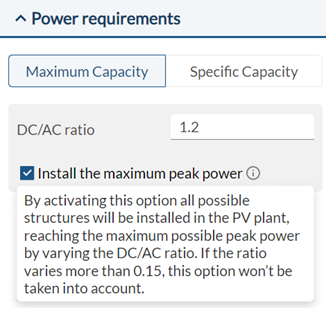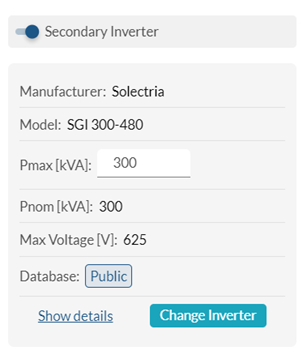This article explains how to reduce unused peak power from uninstalled structures due to the electrical configuration
Introduction
When working in RatedPower, it might occur that some of the structures of your design are highlighted in red. The explanation found in the legend is that the structures are “uninstalled due to an incompatible electrical configuration”. Generating your design with incompatible red structures results in unoccupied space on your site, which subsequently leads to a lesser amount of peak power.
In this article, we will explain how to overcome these issues and make sure that all electrical configuration compatibilities are honored. As the reasons for incompatible electrical configurations are diverse, the following sections will each explain how to solve the varying causes.
Power requirements (maximum capacity)
At the layout tab, you can select the type of capacity configuration your PV plant will follow. To minimize the number of red structures, select maximum capacity and RatedPower will no longer limit the capacity you can set.
 With maximum capacity selected, the software will try to install as many structures as possible. The number of modules per inverter impacts the DC/AC ratio, the simulation is however still limited to the DC/AC ratio set. Allowing this ratio to be slightly different to the one defined (the DC/AC ratio will vary up to +/- 0,15) can resolve small numbers of leftover red structures. If you are flexible in terms of the DC/AC ratio, please try selecting the “Install the maximum peak power” checkbox to resolve this issue.
With maximum capacity selected, the software will try to install as many structures as possible. The number of modules per inverter impacts the DC/AC ratio, the simulation is however still limited to the DC/AC ratio set. Allowing this ratio to be slightly different to the one defined (the DC/AC ratio will vary up to +/- 0,15) can resolve small numbers of leftover red structures. If you are flexible in terms of the DC/AC ratio, please try selecting the “Install the maximum peak power” checkbox to resolve this issue.

Power requirements (specific capacity)
A specific capacity means that the rated power of your plant is defined by the number of inverters selected. Having too few inverters will therefore limit the number of structures possible to install and create red structures whenever there is more power input from the structures than the number of inverters can handle. If you prefer to work with a specific capacity but also want to decrease the number of red structures, simply increase the number of inverters or the DC/AC ratio.
Central Inverters
When you have selected maximum capacity and allow the DC/AC ratio to be somewhat flexible, it is still possible to have structures not installed due to the electrical configuration. This is related to the inverter power selected and can be solved in a couple of ways.
When using central inverters, the number of structures connected to one inverter operates within a certain range.
- Below that range, the cut-in power of the central inverter is not met, implying that the inverter will not be installed.
- Above that range, the DC power exceeds the limit of an inverter and a next inverter has to be installed.
- An additional inverter will consequently only be installed when the cut-in power is met, which is not always the case. Following this reasoning, selecting an inverter with a higher or lower maximum power (Pmax) can resolve the electrical configuration issues.
Secondary central Inverters
Choosing a central inverter that has much higher or lower power than the originally decided upon inverter power is not always desired. The selection of a secondary central inverter might then be the perfect solution for your design.
 A secondary inverter allows RatedPower to transfer the DC power into AC at two different maximum powers. This creates the option to have a large inverter for your larger groups of structures, and a smaller one for the smaller clusters.
A secondary inverter allows RatedPower to transfer the DC power into AC at two different maximum powers. This creates the option to have a large inverter for your larger groups of structures, and a smaller one for the smaller clusters.
String inverters
If there are no inverters in the database small enough to convert the DC power from your structure block into AC output, you can select string inverters. Subsequently, string inverters are then configured for your entire plant.
Single or several available areas
When several available areas (AA-polygons) are defined, by default RatedPower doesn't allow for a power station to be connected to structures outside its original AA. If the structures of a given AA cannot reach the minimum DC power, that power station is left uninstalled. All structures surrounding that power station are consequently also not installed.
However, it is possible to group separate AAs together by enabling the "Group areas in LV" feature during the design process. The software will now connect uninstalled structures from these AAs which could not reach the minimum DC power before, allowing an additional power station to be installed.
To learn more about how you can group separate AAs please check the How to interconnect your available areas in LV article.
Alternatively, if one single AA polygon is defined and this separation between plots is created using restricted areas, a single power station can be connected to structures of different areas. Both methods ensure better coverage of the land and fewer red structures will be generated in your design.
To learn more about how you can unify two or more AAs into one, please check the How to modify a site in QGIS (I): Unify areas article.

Summary
Unused peak power for your PV power plant can be prevented by changing the electrical configuration. Follow the steps visualized below to make sure that all electrical configuration compatibilities are honored.

If you are still not capable of getting rid of the red structures or are having issues in implementing any of the other steps: feel free to contact us.
For any other questions or more information regarding this topic, you can contact us at: support@ratedpower.com
